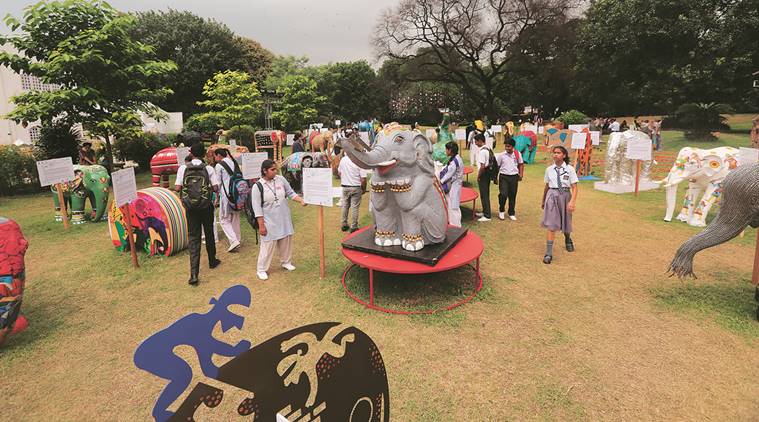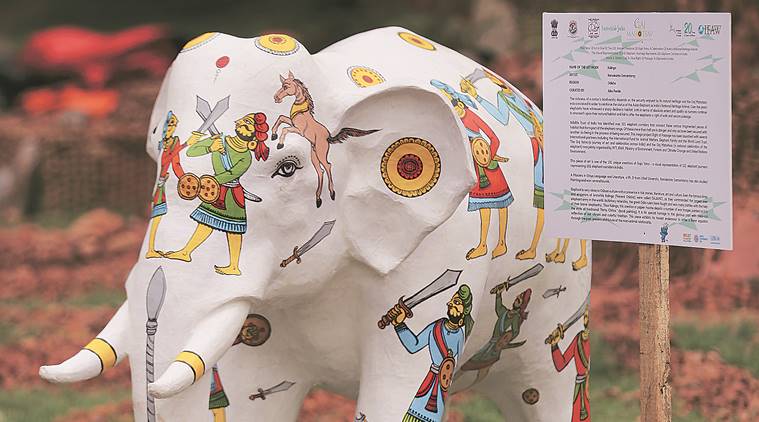The Elephant in the Room
A festival hopes to raise awareness for the protection of elephant corridors through exhibits and curated activities

The ongoing ‘Gaj Mahotsav’ in the Capital features 100 life-sized elephant installations (Express photo by Tashi Tobgyal)
Dressed in turquoise blue, with flowers in varied hues painted across its body, Aana has travelled a long way from Panbari, near Kaziranga National Park, to Delhi’s Indira Gandhi National Center for the Arts (IGNCA), where it is attracting the attention of curious visitors — both kids and adults alike. Painted by artist Bulbul Sharma and school children from Panbari, the life-sized elephant installation even boasts blue blood, with brush strokes added to its vibrant body by the Duke and Duchess of Cambridge, whom it received during their trip to Kaziranga in 2016. Heralding Bihu, the harvest festival in Assam, the elephant doesn’t have the might of the mammoth mammal but it does represent the need for a more even distribution of its population across India; one of the concerns being promoted at the ongoing ‘Gaj Mahotsav’ in the Capital. Speaking for the cause are 100 more life-sized elephant installations, each belonging to one of the elephant corridors spread across India.
“Development and infrastructure cannot be carried out at the expense of encroaching the natural habitats of these majestic creatures. It is imperative to work closely with the forest and wildlife departments to align infrastructure and development efforts with wildlife conservation to create an ideal balance where both can thrive without negatively impacting the other,” said Suresh Prabhu, Minister of Commerce and Industry, at the inauguration of the four-day festival on August 12. Organised by the Ministry of Environment, Forest and Climate Change in association with Wildlife Trust of India and United Nations Environment, the installations are just one of the several attractions of the festival.
While the inaugural day saw performances by Astad Deboo and a Kathak recital by Dahlia Sen, on August 14 occupying the stage will be singer Aditya Jassi and Sonam Kalra, and the closing day will see a performance by the indie band Euphoria. Besides a photography exhibition curated by Alka Pande, and including works by the likes of Akash Das, Navin Sakhuja, Rajesh Bedi and Manju Acharya, various NGOs have been invited to sell elephant-themed products — from elephant-friendly tea to pickles, cushion covers and stoles among others. Inside the seminar hall, discussions are being held on the past and present of elephants, besides film screenings followed by talks with the filmmakers. Many workshops have also been organised to keep the visitors skillfully occupied.
For those approaching the venue in the metro, the journey, too, offers an insight into the conservation efforts and its challenges. On display at Delhi’s Mandi House metro station are illustrations by cartoonist Rohan Chakravarty. His protagonist is Gaju, “a happy-go-lucky baby elephant who loses track of his family”. “If you’ve observed a herd of elephants, you will be wonderstruck at how beautifully they communicate and emote with their dear ones, without relying much on vocalisation,” says Chakravarty.
The venue is dressed in a riot of colours. While Ina Puri has curated an exhibition comprising works by the likes of Paresh Maity, Seema Kohli, Jatin Das and Jayasri Burman, Alka Pande spent months curating the installation project where artists from across the country have produced works using traditional as well as contemporary techniques and craft. If artist Dilip More has used e-waste, from broken computer parts to headphones, for his installation, Gopal Namjoshi has assembled metal junk to put together I Want My Wings Back, urging people to “help them acquire at least safe corridors to ease their migration and engineer their habitats”. Falguni Gokhale paints the elephant king, Airawat, telling its story on a kaavad-like structure where patterns on its white skin speak of the might of the “elephant of the clouds”, capable of bringing rain. “The artists’ works are nuanced and observe the distancing that has caused the present crisis in the forestland. We are united in our endeavor, there is the urgent need to stop an ecological disaster in our environment by acting now,” says Puri.
The festival is on at IGNCA, 11, Mansingh Road, till August 15 from 9 am to 9 pm. Nearest metro station: Central Secretariat






















 Odia artist Ramakanta Samantaray’s Kalinga recalls the several battles won by Odia rulers with the help of their brave ‘elephantry’. He dwells on the man-animal relationship with war images painted in the traditional Pattachitra style on the papier mache installation. (Express photo by Tashi Tobgyal)
Odia artist Ramakanta Samantaray’s Kalinga recalls the several battles won by Odia rulers with the help of their brave ‘elephantry’. He dwells on the man-animal relationship with war images painted in the traditional Pattachitra style on the papier mache installation. (Express photo by Tashi Tobgyal)
No hay comentarios:
Publicar un comentario